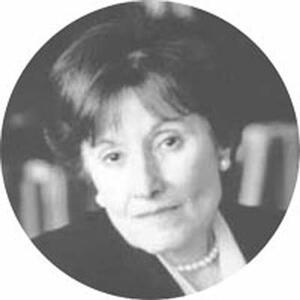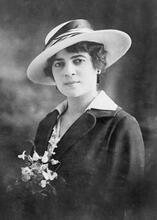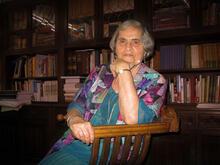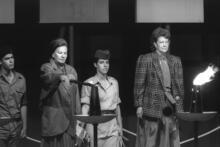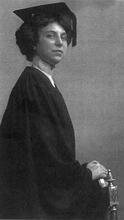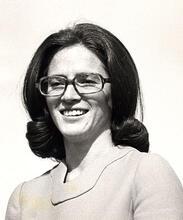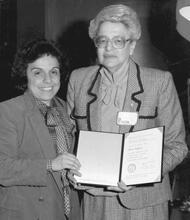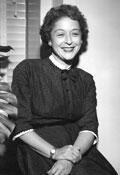Gertrude Himmelfarb
Gertrude Himmelfarb was a prolific and highly awarded historian who in more than fifteen books and countless articles explored and championed the moral imagination of Victorian Britain. She advocated for the reintroduction of values such as shame, responsibility, chastity, and self-reliance into American political life and social policy-making. Her scholarship contributed to the intellectual foundation of the neoconservative movement—of which her husband Irving Kristol was a leader—and the campaign to undermine the welfare state. In the assimilation of nineteenth-century Jews into British society and in British “philosemitism,” she saw the best affirmation of the openness of the Victorian era and further maintained that, more than any other group, the Jewish community epitomized Victorian values such as self-reliance, free-market meritocracy, and philanthropy.
Gertrude Himmelfarb (also known has Bea Kristol) dedicated her long and noted career as a historian of ideas to the study of nineteenth-century Britain, an intellectual commitment that was guided by a profound identification with the moral atmosphere of the Victorian era. Since earning her PhD from the University of Chicago in 1950 and throughout the next seven decades Himmelfarb maintained that the Victorian experience offers unique insights and lessons, immediate and even imperative, for the problems that haunt the modern world. In the 1950s, it was the specter of totalitarianism; in the 1990s, the plight of American inner cities. Himmelfarb became one of the most eloquent advocates, albeit increasingly controversial, for the reintroduction of traditional values (she preferred the term “virtues”), such as shame, responsibility, chastity, and self-reliance, into American political life and policy-making. Her scholarship furnished ammunition for the neoconservative campaign to dismantle the welfare state. It therefore earned her accolades from the likes of New Gingrich, who in 1995, serving as the Speaker of the House of Representatives, argued for bringing back shame “as a means of enforcing proper behavior”—but also the ire of those who regarded her views as retrograde or even mean-spirited.
Family and Education
Gertrude Himmelfarb was born in Brooklyn, New York, on August 8, 1922, the second child of Bertha and glassware manufacturer Max Himmelfarb, both Jewish immigrants from Russia who spoke Yiddish at home. She attended New Utrecht High School in Brooklyn and in 1942 earned a BA from Brooklyn College, with triple majors in history, economics, and philosophy, while also taking courses in history, scripture, and Judaic literature at the Jewish Theological Seminary. The same year, she married Irving Kristol (1920-2009), whom she had first met at a Trotskyite gathering in Brooklyn.
The years that Himmelfarb spent at the University of Chicago, where she embarked on doctoral studies in history in 1942, had the most profound influence on her political approach, style of scholarship, and, no less important, her belief in the utility of historical research. The University of Chicago was then a breeding ground for innovative reformulations of Western political thought as a counterweight to the threats of fascism and communism that ravaged Europe. This effort, high-minded and deeply informed by classical and modern philosophy, was led by European, mostly Jewish, thinkers. It also had a decidedly conservative bent.
Under the supervision of Louis Gottschalk, Himmelfarb wrote her PhD dissertation on the British parliamentarian and historian Lord Acton, which she later published as Lord Acton: A Study in Conscience and Politics (1952). She found Lord Acton’s blend of liberalism and pessimism, ideas of progress and notions of human sinfulness, as well as his advocacy of a “judicious mix of authority, tradition, and experience,” to be highly pertinent for the post-World War II world. Even in this early work, she discerned a connection between the modern neglect of personal moral character and the political catastrophes of the twentieth century, including the rise of fascism and totalitarianism.
A Rightward Turn
In the following decades she continued her exploration of politics, morality, and history in books and articles on leading intellectuals of the Victorian period, most notably John Stuart Mill, whose works she also edited, and Charles Darwin. The Idea of Poverty: England in the Early Industrial Age (1984) examined the rise of poverty as a publically debated social problem and was her first direct attempt to exonerate the early Victorian treatment of the poor. This was followed by the anthology Marriage and Morals Among the Victorians (1986) and her exploration of late Victorian attitudes toward social issues in Poverty and Compassion: The Moral Imagination of the Late Victorians (1991). In both books, she seems to lament the replacement of Victorian moral nerve with Edwardian aestheticism and “value-free” relativism.
In subsequent years Kristol and Himmelfarb veered dramatically to the political right. He would emerge as one of the leaders—sometimes crowned the “godfather”—of the neoconservative movement. The couple was greatly involved in the Jewish conservative intellectual circles that evolved around, among other catalysts, journals such as Partisan Review and later Commentary and Encounter. Kristol would write that he was “astonished how intellectually twinned” the two of them were. Both also typified a neoconservative proclivity for strong anglophilia. As writer Jacob Heilbrunner wrote, “The neoconservatives would play a surprising role in propagating nostalgia for the English aristocracy.” They had two children, Elizabeth Nelson and William Kristol. A conservative writer and commentator, William “Bill” Kristol served as Vice President Dan Quayle’s chief of staff. He founded and edited the Weekly Standard and later was the editor-at-large of The Bulwark. Himmelfarb’s brother, Milton, who assumed leadership positions in the American Jewish Committee was also known as a conservative essayist.
A Decorated Outsider
During her prolific career Himmelfarb received prestigious awards (among them, fellowships from the Rockefeller, Guggenheim, and Wilson foundations) and honorary degrees (from institutions such as Yale, Williams College, Jewish Theological Seminary, and Smith College) and served on important boards (including the Council of Scholars of the Library of Congress and the Council of the National Endowment of the Humanities). In 2004, President George W. Bush awarded her the National Humanities Medal.
Nevertheless, Himmelfarb was somewhat of an outsider in the historical profession. She had engaged in independent research for fifteen years before joining City College of the City University of New York in 1965 and, later, the University’s Graduate Center. By then, the discipline of history was increasingly influenced by methodologies and insights borrowed from the social sciences. Himmelfarb harshly criticized the departure from traditional models of historical scholarship and argued that the dominance of the new social history “belittles the will, ideas, actions, and freedom of individuals” (Of Heroes, Villains, and Valets). The New History and the Old (1987) constituted an outright attack on Marxist determinism, quanto-history, and psychohistory, as well as other types of narrativeless “history with the politics left out.” As in her political critique, she reproached academic historians for their alleged moral relativism, disregard for human achievements (or “greatness”), and refusal to identify heroes and villains in their writings. When postmodernism became the academic vogue, its manifestations in historiography (especially in feminist history) did not escape Himmelfarb’s acerbic pen. Postmodernist history, she wrote, “recognizes no reality principle, only the pleasure principle—history at the pleasure of the historian.” She also argued against multiculturalism in historical studies, asserting that such an approach trivializes history and renders it meaningless and that it “demeans and dehumanizes the people who are the subjects of history” by denying the “common (generic) humanity of all people, whatever their sex, race, class, religion and the like” (“Telling it as you like it”).
In One Nation, Two Cultures (1999), subtitled “A Searching Examination of American Society in the Aftermath of our Cultural Revolution,” Himmelfarb posited that the counter-culture of the 1960s had become the dominant culture—particularly in the media and the university—but that a “dissident culture” continued to promote such values as family, civil society, patriotism, and sexual morality. It was to the credit of America, she maintained, that we remain “one nation” even as we are divided into “two cultures.”
Fighting the Culture Wars
After more than two decades at City University of New York Himmelfarb retired in 1987 and moved with her husband to Washington, DC, where she continued to focus on her writing. In The De-Moralization of Society (1995), Himmelfarb compared Victorian societies on both sides of the Atlantic to modern America and found the latter lacking. The Victorians were highly successful in curbing social ills such as crime, illegitimacy, poverty, and illiteracy by making morality “a conscious part of social policy.” Conversely, the constant deterioration of the American social condition, argued Himmelfarb, is rooted in a climate of skepticism and “de-moralization.” Following the nineteenth-century British writer Thomas Carlyle, she maintained that social problems cannot be reduced to economic calculations and material gains. As important is the insistence on the moral disposition of the weakest echelons of society, their sense of right and wrong. The re-moralization of society, she argued, would necessitate assigning social stigmas to practices such as out of wedlock births, as well as reshaping reliance on public assistance. Thus Himmelfarb found the Victorian distinction (derided by generations of historians) between the “deserving” and “undeserving” poor to be particularly inspiring, as she did the idea of “less eligibility” institutionalized in the first Victorian welfare reform (the Poor Law Act of 1834) to discourage “able bodied paupers” from seeking public assistance. She also found merit in Newt Gingrich’s proposal to resurrect old, discredited Victorian institutions such as orphanages. In her view, these institutions were highly effective and certainly more humane than one might gather from Dickensian “exaggerations.”
The De-Moralization of Society and much of Himmelfarb’s writing in the preceding decade met with controversy, both political and scholarly. The dispute over her work, which in the past was largely praised for its prodigious scholarship, elegance, and lucidity, grew as her writings focused on the present rather than on the past and as her tone became more bellicose. One critic even accused her of writing a “revisionist history” for the Republican party. Ultimately, new-conservatism gained only a rather minor footprint in American historical scholarship.
Himmelfarb and Jewish History
In De-Moralization of Society, Himmelfarb dedicated a chapter to the “Jew as a Victorian.” The assimilation of Jews, she maintained, was one of the clearest indications of the openness and social advancement of the Victorian era. Moreover, she argued that the Jewish community more than any other segment of the British population epitomized a host of Victorian values: self-reliance, free-market meritocracy, and philanthropy. In a symposium on “Liberals and the Jews,” published by Commentary in January 1980, Himmelfarb contended that the traditional Jewish affiliation with liberalism has been maintained by a “nostalgic commitment” to the old nineteenth-century liberalism that accepted Jews as individuals and as a group. But “latter-day liberalism,” with its support of discriminating quotas, rejection of individualism, and hostility towards Israel, was, according to Himmelfarb, inhospitable to Jews. “We may conclude,” she opined, “that a quite different philosophy is required if we are to survive in the modern world, survive as individuals and Jews.” Later in life she returned to Jewish topics. In The Jewish Odyssey of George Eliot (2009), she focused on Eliot’s novel Daniel Deronda’s (1876) positive conception of Jews as a nation and a polity unburdened by the view of the Jews as perpetual victims, martyrs, or survivors and of Israel as predominantly a refuge of Jews escaping prejudice and oppression. She pursued similar themes in People of the Book: Philosemitism in England, From Cromwell to Churchill (2011), voicing her hope that a history of philosemitism may help counteract this “lachrymose” view of Jewish history.
Gertrude Himmelfarb died on December 30, 2019.
Selected Works by Gertrude Himmelfarb
Lord Acton: A Study in Conscience and Politics. Chicago: University of Chicago Press, 1952.
Darwin and the Darwinian Revolution. Garden City, NY: Anchor Books, 1959.
Victorian Minds. London: Weidenfeld and Nicolson, 1968.
On Liberty and Liberalism: The Case of John Stuart Mill. New York: Knopf, 1974.
The Idea of Poverty: England in the Early Industrial Age. New York: Knopf, 1984.
Marriage and Morals Among the Victorians. New York: Knopf, 1986.
The New History and the Old. Cambridge, MA: Belknap Press of Harvard University Press, 1987.
Poverty and Compassion: The Moral Imagination of the Late Victorians. New York: Vintage Books, 1991.
“Of Heroes, Villains, and Valets.” Commentary 91, no. 12 (June 1991): 20–26.
“Telling it as You Like it—Post-Modernist History and the Flight from Fact.” Times Literary Supplement 16 (October 1992): 12–15.
On Looking into the Abyss: Untimely Thoughts on Culture and Society. New York: Knopf, 1994.
“A Demoralized Society—The British American Experience,” Public Interest 117 (Fall 1994): 57–80.
The De-Moralization of Society. New York: Vintage Books, 1995.
One Nation, Two Cultures. New York: Knopf, 1999.
The Roads to Modernity: The British, French and American Enlightenments. New York: Knopf, 2004.
The Moral Imagination from Edmund Burke to Lionel Trilling. Chicago: Ivan R. Dee, 2006.
The Jewish Odyssey of George Eliot. New York: Encounter Books, 2009.
The People of the Book: Philosemitism in England, from Cromwell to Churchill. New York: Encounter Books, 2011.
Past and Present: The Challenges of Modernity, from the pre-Victorians to the Postmodernists. New York: Encounter Books, 2017).
SELECTED WORKS EDITED BY GERTRUDE HIMMELFARB
Lord Acton, Essays on Freedom and Power. Boston: Beacon Press, 1948; Reprints, 1955, 1984.
Malthus, Thomas Robert. Essays on Population. New York: Modern Library, 1960.
John Stuart Mill, Essays on Politics and Culture. Garden City, NY: Doubleday, 1962; Reprints, 1963, 1971.
John Stuart Mill, On Liberty. New York: Penguin, 1974.
Alexis de Tocqueville, Memoir on Pauperism. London: IEA Health and Welfare Unit, 1997.
Alexis de Tocqueville, The Spirit of the Age: Victorian Essays. New Haven: Yale University Press, 2007.
Brooks, David. “The Historian of Moral Revolution.” The Atlantic December 31, 2019.
Contemporary Authors (1975).
Current Biography (1985).
Heilbrunn, Jacob. They Knew They Were Right: The Rise of the Neocons. New York: Random House, 2009.
Levine, Yuval. “The Historian as a Moralist.” National Review, December 31, 2019.
Martin, Douglas, and Daniel Slotnik. “Gertrude Himmelfarb, Conservative Historian of Ideas, Dies at 97.” New York Times, January 1, 2020.
Torrance, Kelly Jane. “Victorian Values.” The University of Chicago Magazine, March-April, 2012.
World Authors 1980-1985 (1991).
The Writers Directory (1988–1990, 1988).

